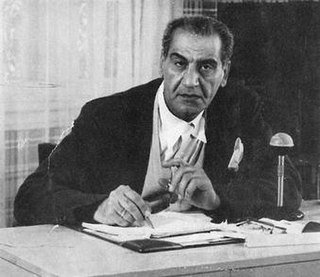Related Research Articles

Armenian Secret Army for the Liberation of Armenia (ASALA) was a militant organization active between 1975 and the 1990s whose stated goal was "to compel the Turkish Government to acknowledge publicly its responsibility for the Armenian genocide in 1915, pay reparations, and cede territory for an Armenian homeland." ASALA itself and other sources described it as a guerilla and armed organization. Some sources, including United States Department of State, as well as the Ministry of Foreign Affairs of Azerbaijan listed it as a terrorist organization.

Colonel Atilla Altıkat was the Turkish military attaché to the Turkish Embassy in Ottawa, Ontario, Canada, and was assassinated in 1982. The Armenian militant group ASALA claimed responsibility for the attack. The act was forcefully condemned by the Prime Minister of Canada, Pierre Trudeau.
Justice Commandos of the Armenian Genocide (JCAG) was an Armenian militant organization active from 1975 to 1987.
The Armenian Revolutionary Army (ARA) was an Armenian militant organization that attacked at least 7 times resulting in at least 6 fatalities and 8 injuries. The group took responsibility for the gunning down of Turkish Embassy attache Dursun Aksoy in Brussels (1983), an attack on Turkish embassy in Lisbon (1983), and the attack on the Turkish Embassy in Ottawa (1985).
Hampig Sassounian or Harry M. Sassounian, is an American citizen involved in the 1982 assassination of Turkish Consul General Kemal Arıkan in Los Angeles. He was identified as one of two gunmen by witnesses. In court, Sassounian said that he was motivated by the Turkish government's open denial of the Armenian genocide. The jury determined that Arıkan was targeted due to his nationality. Sassounian was sentenced to life, but was granted parole 2021. He subsequently moved to Armenia on 29 October 2021.

Hagop Hagopian was one of the founders and the main leader of ASALA.

Hüseyin Daniş Tunalıgil was a Turkish diplomat. He was assassinated by JCAG in 1975 during his duty as the Turkish ambassador to Austria.

Ahmet Benler was the son of Özdemir Benler, the Turkish ambassador to the Netherlands. He was assassinated on October 12, 1979, in The Hague. The responsibility for his assassination was claimed separately by ASALA and JCAG.
Galip Balkar, Turkish ambassador to Yugoslavia, was assassinated on 9 March 1983 in downtown Belgrade, capital of Yugoslavia. He died two days later as a consequence. The responsibility for the attack was taken by the Justice Commandos of the Armenian Genocide (JCAG), an Armenian militant group.
The assassination of Taha Carım, a Turkish diplomat and ambassador to the Holy See, took place on 9 June 1977 in Rome, Italy.

Taha Carım (1914-1977) was a Turkish diplomat who held several high-ranking posts in Turkish foreign service and was assassinated by Armenian gunmen from Justice Commandos of the Armenian Genocide.
Galip Ozmen was the Administrative Attaché of Turkish Embassy in Greece and Turkish intelligence (MIT) agent, who was assassinated in Athens on 31 July 1980 by the Armenian Secret Army for the Liberation of Armenia (ASALA). An Armenian gunman attacked Galip Ozmen, 45, and his family as they were waiting in their automobile in the Pangrati area of Athens. Galip Ozmen was killed and his fourteen-year-old daughter, Neslihan Ozmen, later died of her wounds. His wife, Sevil Ozmen, and his sixteen-year-old son, Kaan Ozmen, were seriously wounded, but survived.
The assassination of Erkut Akbay refers to the murder of the Turkish administrative attache, Erkut Akbay, 40, in Lisbon, where the diplomat was serving, on 7 June 1982. Akbay was assassinated near his home on the outskirts of the city as he returned home for lunch. He was killed instantly while sitting in his car. His wife, Nadide Akbay, 39, was also shot in the head as she sat beside him. Nadide was rushed to a hospital in a coma and underwent surgery. She died after eight months in coma on 11 January 1983 at Ankara Hospital.
The assassination of Orhan Gündüz, Turkish businessman and diplomat, took place on May 4, 1982, in Somerville, Massachusetts.
Events in the year 1983 in Turkey.

Gourgen Mkrtich Yanikian was an Armenian genocide survivor. He is best known for the assassination of two Turkish consular officials, Consul General Mehmet Baydar and Consul Bahadır Demir. The event took place in Santa Barbara, California in 1973.
References
- ↑ New York Times. Turk Slain in Brussels; Armenians Claim Deed. 15 July 1983
- ↑ Turkish Diplomat Shot To Death In Car. The Montreal Gazette, 15 July 1983
- 1 2 Turkish Diplomat Slain in Brussels. Sarasota Herald-Tribune, 15 July 1983
- ↑ "Şehit diplomat Dursun Aksoy anıldı" (in Turkish). Hürriyet. 14 July 2021. Retrieved 22 August 2021.